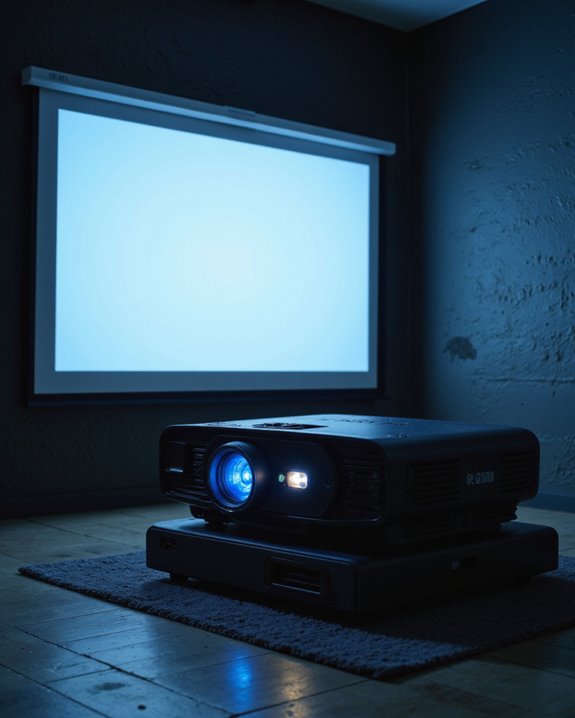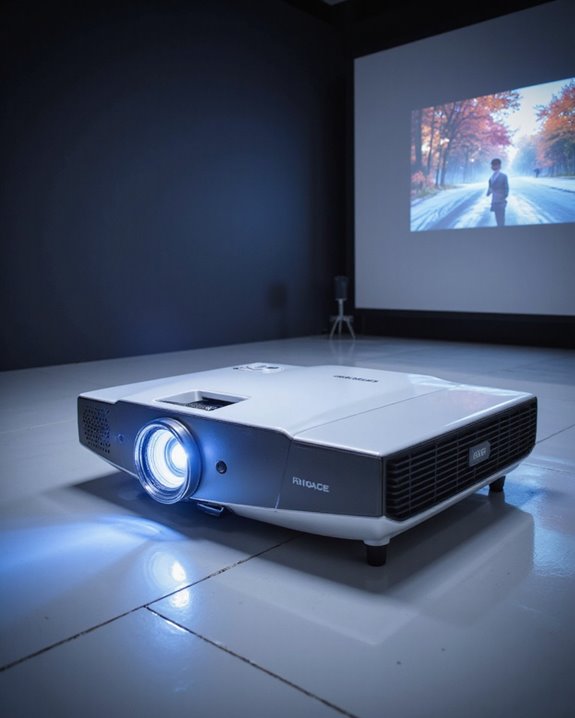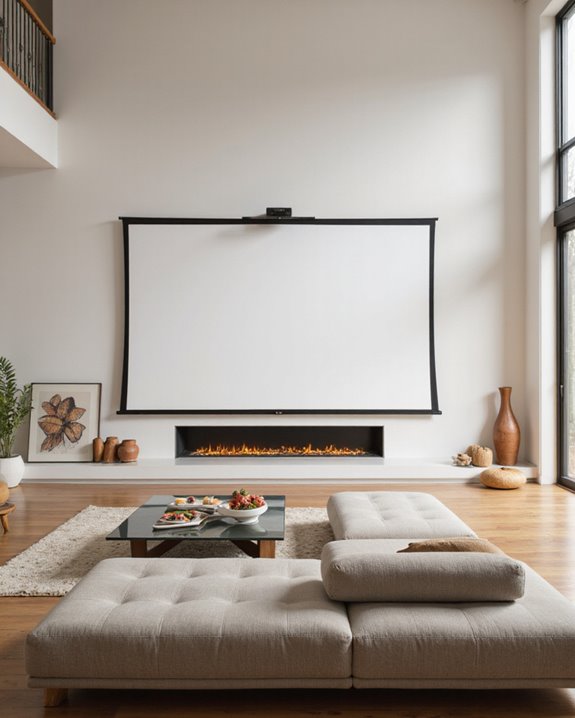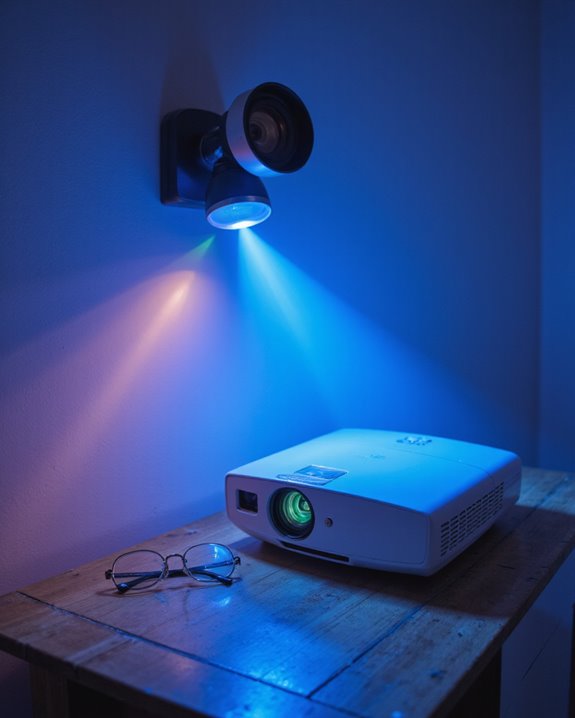Epson dominates the projector market in 2024, offering superior models for both home theater and office use. Their 3LCD technology delivers vibrant colors and high brightness levels up to 2700 lumens, while their laser engines provide consistent performance. BenQ and Sony follow closely, with BenQ specializing in DLP technology and Sony focusing on premium home theater solutions. Each manufacturer brings unique strengths, from Epson’s versatility to Sony’s superior contrast ratios, making the choice dependent on specific needs and preferences. A deeper analysis reveals additional factors worth considering.
Key Takeaways
- Epson leads in both home and office projectors with its 3LCD technology, offering high brightness levels and sustainable laser engines.
- Sony excels in premium home theater solutions with superior SXRD technology, contrast ratios, and enhanced HDR content processing.
- BenQ specializes in DLP technology projectors, delivering vibrant colors and reliable performance across various price points.
- JVC’s D-ILA projectors stand out for deep blacks and smooth color gradients, making them ideal for high-end home theaters.
- Hisense offers competitive 4K resolution options at mid-range prices, particularly excelling in ultra-short throw (UST) projector technology.
Understanding Today’s Top Projector Brands
When evaluating projector brands in today’s market, understanding the key players and their specialties becomes essential for making informed purchasing decisions. Leading manufacturers like Epson, BenQ, and Sony have established strong brand reputations through consistent product quality and innovation. Top brands for 2025 include a diverse range of options tailored for various needs, from home entertainment to professional presentations. Epson stands out for its sustainability initiatives and dual excellence in both home and office projectors, offering high-quality 4K capabilities for entertainment and robust business solutions. BenQ specializes in DLP technology, delivering vibrant colors across both sectors, while Sony focuses on premium home theater solutions with superior contrast and color accuracy. For office environments, companies like NEC and Panasonic have carved out niches with their reliable business projectors, featuring high brightness levels and advanced connectivity options that meet professional presentation needs. With the global projector market expected to reach $14.53 billion by 2029, manufacturers continue to invest heavily in research and development to maintain their competitive edge.
Comparing Picture Quality Across Major Manufacturers
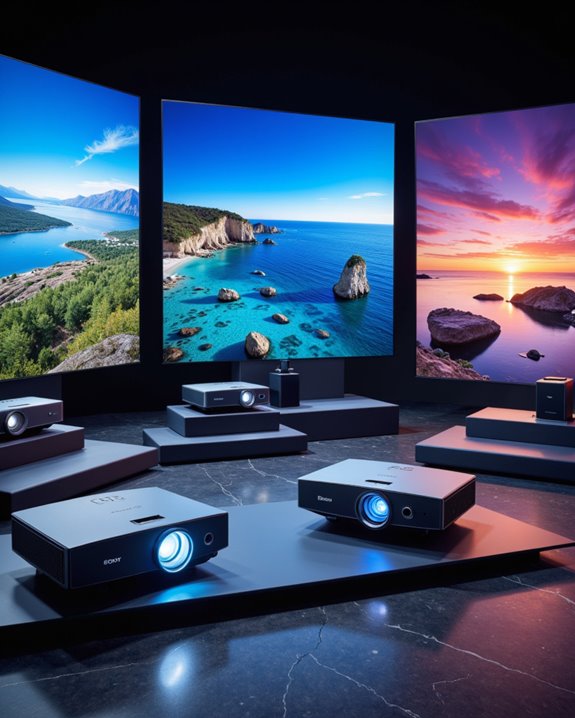
As projector technology continues to advance, picture quality has become a defining factor that sets leading manufacturers apart. Sony’s SXRD technology delivers exceptional sharpness and contrast, while Epson’s 3LCD system produces vibrant colors with superior brightness levels of up to 2700 lumens. JVC’s D-ILA projectors excel in producing deep blacks and smooth color gradients, often requiring minimal projection calibration out of the box. Additionally, color accuracy plays a crucial role in creating realistic and immersive visuals, making it a key consideration for consumers seeking high-end displays.
Each brand offers distinct advantages in color accuracy and image processing. Sony’s X1 Ultimate processor enhances HDR content effectively, while Epson’s laser engines provide consistent brightness in various lighting conditions. LG’s DLP-based CineBeam series offers sharp 4K images, though it may show occasional rainbow effects. For home theater enthusiasts, JVC and Sony lead in pure picture quality, while Epson balances versatility with performance. BenQ’s latest models feature impressive 600,000:1 contrast ratio for enhanced depth and realism in dark scenes.
Performance Features That Set Leaders Apart
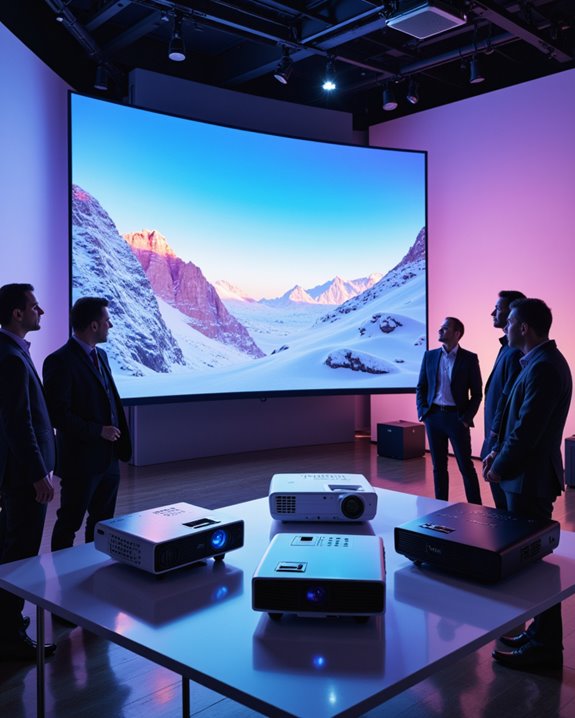
The leading projector brands distinguish themselves through several key performance features that define their market positions. Projection technology advances have enabled manufacturers to achieve superior brightness levels of 3000-6500 lumens while maintaining excellent contrast ratios. Brand reputation often correlates with how well companies balance these essential elements.
Top manufacturers differentiate themselves by incorporating advanced color processing systems and HDR support, ensuring accurate reproduction of images in both home and office environments. Companies like Epson have established themselves as industry leaders by offering projectors with pixel-shifting technology that delivers exceptionally sharp image quality. Their projectors typically feature extensive connectivity options, including HDMI 2.1 and wireless capabilities, along with smart platforms for enhanced usability. The most successful brands also prioritize build quality and reliability, offering robust calibration options that allow users to optimize performance for specific viewing conditions. Additionally, incorporating advanced image processing helps these companies deliver clearer, more detailed visuals, setting them apart from competitors. These combined features establish clear leaders in the competitive projector market.
Best Home Theater Projector Manufacturers
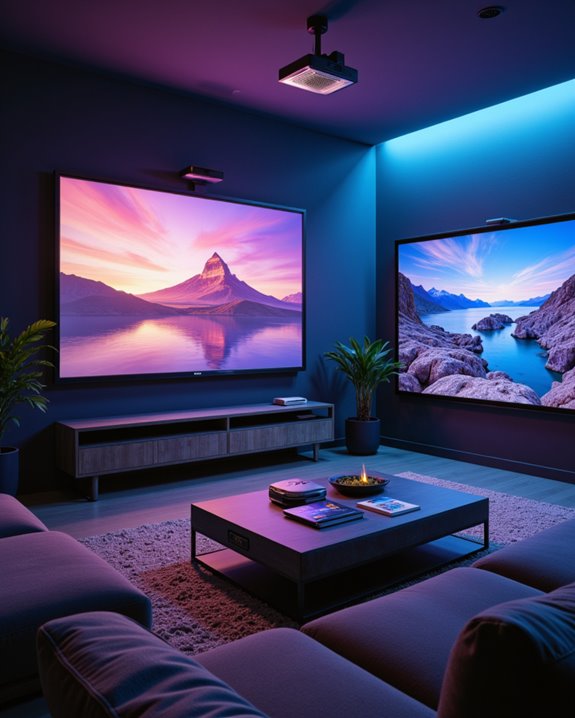
Leading home theater projector manufacturers have established clear market positions through distinctive technological innovations and specialized features. In projection technology, Sony and JVC dominate the premium segment with true native 4K resolution and superior contrast ratios. Epson’s brand innovation shines through their laser light engines and exceptional picture quality in models like the Home Cinema 5050UB.
Recent market developments show manufacturers focusing on specific strengths. Sony excels in lens quality and sharp imaging, while JVC’s D-ILA technology delivers industry-leading black levels. BenQ emphasizes color accuracy with their CinematicColor technology, and Hisense stands out with ultra-short throw RGB laser projectors featuring integrated audio. These manufacturers continue pushing boundaries in different areas: resolution, contrast, color reproduction, and placement flexibility, giving consumers targeted options for their specific needs. Manufacturers are increasingly incorporating HDR10+ support into their projectors, enhancing dynamic range and color accuracy across all price points.
Top Brands for Office and Business Projectors
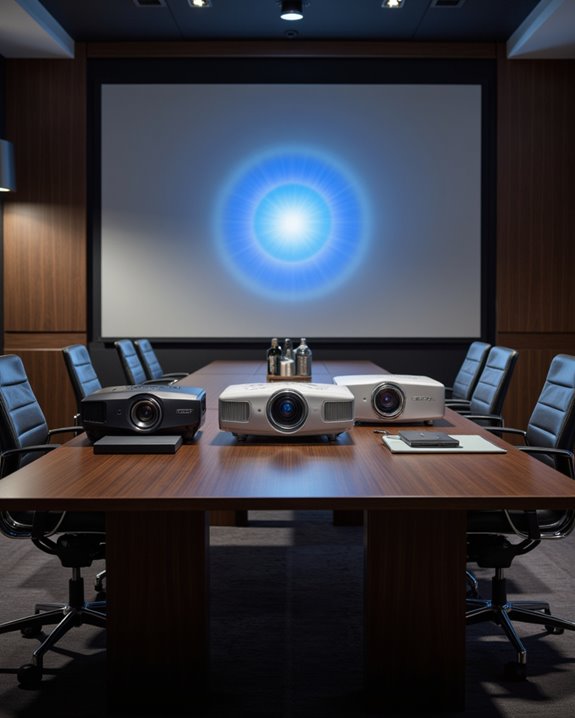
Major office and business projector brands have carved distinct market positions through specialized features targeting professional environments. Leading manufacturers like Epson and BenQ focus on smart projection capabilities, offering high brightness levels and advanced connectivity options. Ricoh and Optoma stand out for their environmental sustainability initiatives and laser projection technology.
ViewSonic and Sony have established themselves through superior image quality and contrast ratios, while Canon and Panasonic excel in durability and innovative features. Epson’s PowerLite series showcases WUXGA resolution support for enhanced visual clarity. Notable technological advancements include:
- Wireless connectivity for seamless presentations
- 4K resolution options for crystal-clear displays
- Laser projection systems that reduce power consumption
- DLP and LCD technologies for enhanced image quality
The market continues to grow, projected to reach $11.78 billion by 2025, driven by increasing demand for professional presentation tools and technological innovations.
Ultra Short Throw Projector Market Leaders
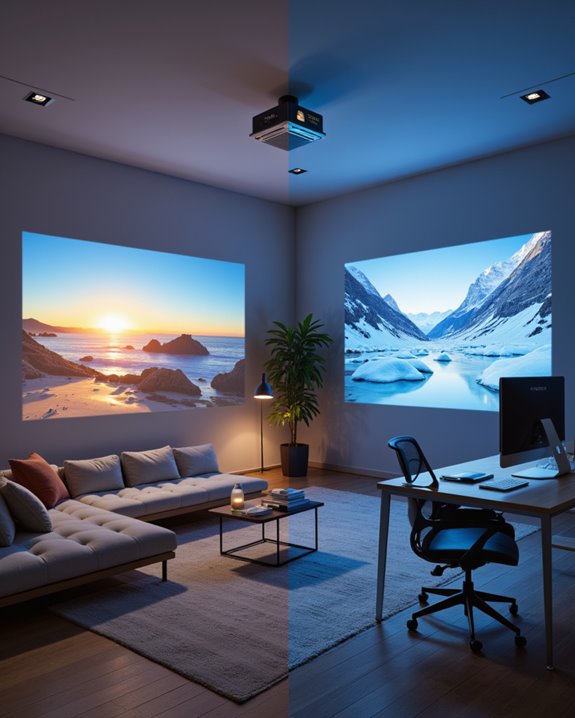
Among the leading ultra short throw projector manufacturers, Epson stands out with its EpiqVision Ultra series offering impressive 4000 lumens brightness. When comparing manufacturers in the UST space, Hisense provides competitive 4K resolution options, while Optoma delivers versatile throw ratios across their lineup. Based on the latest models from these companies, each brand brings distinct advantages – Epson excels in brightness and color accuracy with 3LCD technology, Hisense focuses on 4K resolution at mid-range price points, and Optoma balances performance with value across their projector portfolio.
Value for Money: Budget Vs Premium Brands
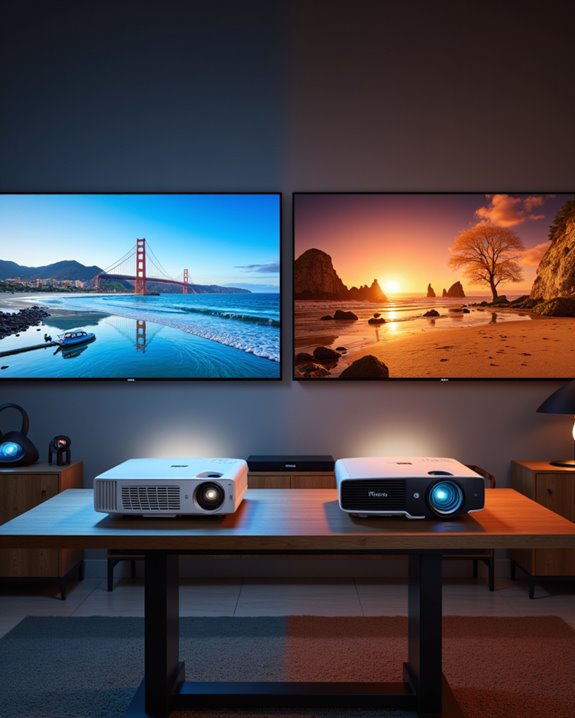
The choice between budget and premium projector brands presents a significant cost-benefit consideration for consumers seeking the right balance of features and price. Budget brands like BenQ, ViewSonic, and Epson’s entry-level models offer good value while keeping costs low. These options typically include basic warranty services and require minimal projector maintenance. The ViewSonic PA503W delivers high lumen output that makes it especially effective for brightly lit office environments.
Premium manufacturers such as Sony, JVC, and high-end Epson models command higher prices but deliver superior features and more exhaustive warranty coverage. These projectors often include advanced maintenance monitoring systems and longer service agreements. While budget options provide adequate performance for casual users, premium models offer better long-term value through enhanced durability, superior image quality, and more sophisticated features. The decision ultimately depends on specific needs, usage frequency, and available budget for both initial purchase and ongoing maintenance.
Future-Ready Projector Companies to Watch
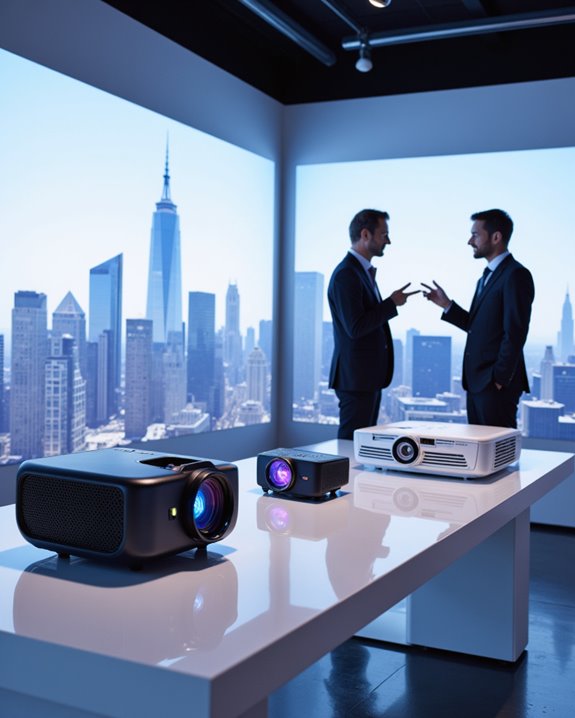
Several innovative projector manufacturers are positioning themselves at the forefront of technological advancement, shaping the future of home and office display solutions. Companies like Epson and Hisense demonstrate strong projection longevity through their use of laser technology, which offers up to 20,000 hours of viewing time. These manufacturers also emphasize environmental sustainability by reducing power consumption and using eco-friendly materials.
Leading brands are developing features that will remain relevant for years to come. Hisense’s L9Q Trichroma Laser TV and Samsung’s Premiere 5 showcase advanced capabilities like ultra-short throw technology and built-in smart systems. BenQ and Valerion focus on delivering high-quality images while maintaining competitive pricing. Many of these companies integrate AI-powered adjustments and voice control, ensuring their projectors adapt to future technological demands. High-end projectors like the Epson Home Cinema 5050UB deliver superb picture quality through excellent contrast ratios and accurate color reproduction.
Frequently Asked Questions
How Long Do Laser Projectors Typically Last Before Needing Replacement?
Laser projectors demonstrate exceptional lifespan, typically lasting between 20,000 to 50,000 hours before requiring replacement. This bulb longevity translates to approximately 12 years of regular use under proper maintenance and operating conditions.
Can Projectors Damage Eyes When Viewing Content for Extended Periods?
Like a gentle sunset, projectors rarely cause permanent eye damage. However, extended viewing can lead to temporary eye strain and viewing fatigue. Taking regular breaks and maintaining proper lighting helps prevent discomfort.
What Type of Screen Material Works Best With 4K Projectors?
For 4K projectors, specialized white or gray screens offer ideal screen enhancement and material durability. Matte white provides excellent color accuracy in controlled lighting, while high-contrast gray performs better in ambient light environments.
Do Projectors Consume More Electricity Than Large-Screen TVS?
Studies show large-screen TVs can consume up to 1000 watts, while most projectors use 200-500 watts. Generally, projectors have better power efficiency and lower overall energy consumption, especially with modern LED lamp technology.
How Often Should Projector Filters and Vents Be Cleaned?
Filter maintenance and ventilation cleaning should occur every 100-200 hours of use, or monthly in dusty environments. Regular inspection is recommended, with immediate cleaning if dust accumulation becomes visible or fan noise increases.


